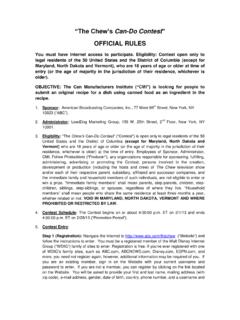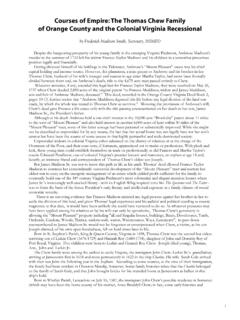Transcription of Chew Toys and Treats: The Right One For Your Dog
1 chew toys and Treats: The Right One For Your Dog By Sharon Klar, DVM When discussing chew toys with dog owners, I get asked a lot of questions about what is safe and healthy for dogs. I have a very simple answer that will solve all of your various brand name queries and concerns: Nothing! Nothing is safe for your dog to chew on. I am certain that whatever you may ask about, whether it is Nylabones, rawhides, edible chew bones, Greenies, veterinarian-recommended and ASPCA-approved chews, or plain old sticks, the fact is that a veterinarian somewhere, at some time, has removed it from a dog s gastro-intestinal tract. Despite this simple answer, dogs still need to chew . Having already said that nothing is one-hundred percent safe, let s look at the options. When you go to a PetSmart or PetCo, or anywhere else that sells dog toys , the first thing to notice is that there are a LOT of them. Basic types of chews Rawhide: Rawhide bones, chips, (thin slabs) rolled sticks, etc.
2 Plain or basted. Rawhides are the hides of cows with no fur on them. They are a non-digestible protein, which has no nutritional value, but they will break down and be passed through the digestive tract given the Right circumstances. Many dogs will chew off hunks and swallow them and these can become obstructed in the tract; and some dogs will soften them up to a point and then just try and swallow them, which can cause gagging and possibly choking. Some dogs chew carefully and deliberately and apparently never have a problem with rawhides. Too many rawhides can cause diarrhea and sometimes vomiting. A word about rawhide processing. There is a company called VetSolutions that make an oral care chew which is rawhide coated with lysozyme, lactoferrin, and lactoperoxidase which are enzymes found in saliva. I called the company to discuss processing since I have read on the Internet that rawhides are processed with Lye and/or formaldehyde and here is what they told me.
3 According to Dan, (who owns English Bulldogs), this particular company only uses American beefhide, and the processing itself is done in Mexico. The beefhide goes through a hydrogen peroxide bath (Dan did not know the concentration) in order to bleach and disinfect. After a rinse bath it is then dried and then the enzymes are applied. Dan told me that 99% of rawhide processing everywhere - not just his company - uses hydrogen peroxide to bleach and disinfect, and that lye and formaldehyde are never used. So is hydrogen peroxide safe? Well, it is in a lot of toothpastes and teeth whiteners, and vets will sometimes give it to dogs to make them throw up. (Does that answer the question? I didn t think so, but you can make your own decision about that.) Pressed Rawhide: Same as above, except that it is made of tiny pieces of rawhide that is stuck together with a gelatin base. There is presumably somewhat less of a choking issue with pressed rawhide.
4 Nylabones: The true Nylabone which is made of nylon and is very hard and indestructible is a popular option. Your dog may be able to work off small nylon fibers which pass easily through the digestive tract, and that is the idea anyway. Are these small fibers harmful to your dog even if they don t cause obstruction? I don t know. I haven t found any scientific studies that have shown any correlation between tiny nylon fibers and disease so far. But because this product is not one-hundred percent natural, it doesn t always appeal to owners. It doesn t always appeal to dogs either. Some dogs are completely non-plussed with the idea of gnawing on nylon. If your dog does happen to love nylon chews go for the brand name and make sure you throw it away when it becomes too whittled down. Edible chew bones: These tend to appeal to owners because they are made with all-natural digestible material, but are hard enough to clean the dog s teeth and provide hours of chewing fun.
5 They also have the highest incidence of breaking off chunks or pieces that can tear up dogs intestines. They do not show up on radiographs very easily, if at all, making diagnosis very challenging. Brand name or not, these can be potentially very hazardous. Greenies: Same as above, with chlorophyll to freshen breath. Due to the problematic nature of becoming stuck in the tract, Greenies have recently changed their formula and are now more flexible and rounded. Will this solve the problem? I have no idea; they are new so only time will tell. Pig s ears, and hooves: Keep in mind your dog will probably lick your face. If that is not deterrent enough, what with the smell, then consider that both of these items can break off pieces which can cause damage, and that they are junk food. Pig s ears do have caloric content with all the skin, fat and blood vessels.
6 Real bones: Of course real bones have the potential to be harmful, but it s a popular option with really big dogs. Never use cooked bones as cooking causes them to be dry and splintery. If you get fresh bones, practice safe food handling such as not letting the bones sit around for a long time, and wash your hands after handling. De-worm your dog regularly, just in case. There are plenty of bacteria and other pathogens associated with human-quality meats and bones. Discard dry and weathered bones. Make sure the bone is large enough that the dog cannot swallow it or parts of it whole. Most likely this is going to be an outside chew , so it requires extra supervision on your part to make sure your dog is safe. Sticks: The original chew toy. They are potentially hazardous especially if your dog is eating the pieces, but a lot of dogs do not actually eat the stick, they simply make shredded wet woodchips.
7 This is an outside chew toy also and requires you to supervise the chewing outside. Make sure you know what type of wood is within reach and check on potential toxicity of different species. (Note: If your dog chews rocks this is never a good thing!) Stuffed toys : When looking for any toy for your dog, it is important to visualize what this toy will look like after it has been seriously chewed. If there are small pieces like eyes, or plastic parts that can be easily chewed to bits, then it s probably less safe. The toys that are made of flimsy plastic and are easily destroyed are not safe at all. The plain fleece toys are safer, but any stuffed toy, whether or not it has a squeaker, should be discarded when the seams rip and stuffing starts coming out. Durable rubber toys like Kongs are pretty well indestructible provided that you have the Right size for your dog. These toys can be filled with biscuits, food, etc.
8 And frozen. Any heavy-duty rubber toy should be thrown away if the rubber starts to look worn. People ask me what I give my dog for a chew treat and my answer is simple. When my Anatolian puppy wants to chew I give him our Lab: I feel good knowing that it is a one-hundred percent natural, highly digestible protein source, and he is unlikely to chew off large enough pieces that will get lodged in his tract. So when you pick out a chew treat for your dog, buy the Right size, make an informed choice, and always supervise the chewing. Never leave bags of treats that are meant to be ingested within reach as too many at one time could be disastrous, and when in doubt, get a Lab. Besides the Lab, the dogs have a toy basket with fleece toys , Durable-type Nylabones, (giant size) and since my husband is a hunter, our dogs get elk, moose, and buffalo femurs from time to time. They also prune our yard removing and destroying dead wood.
9 They are on Heartguard year-round and have regular supervision.










